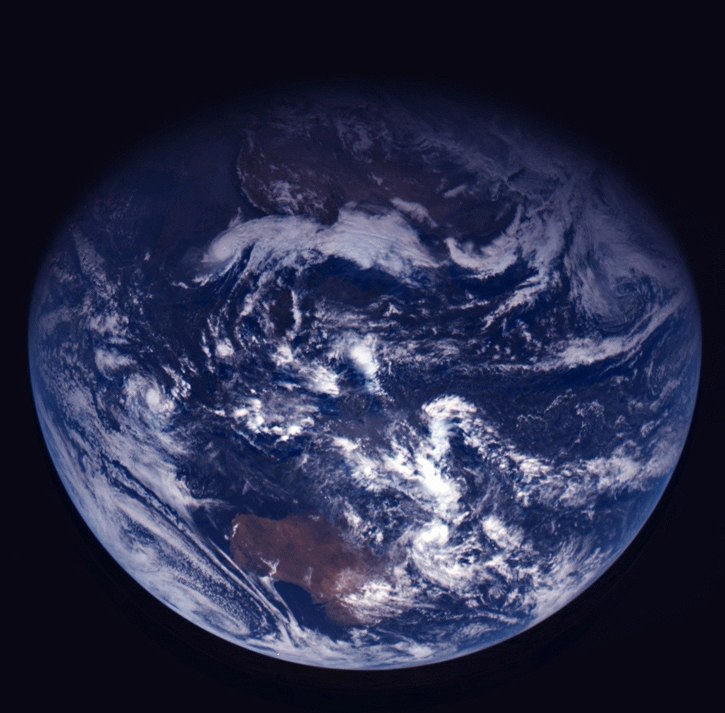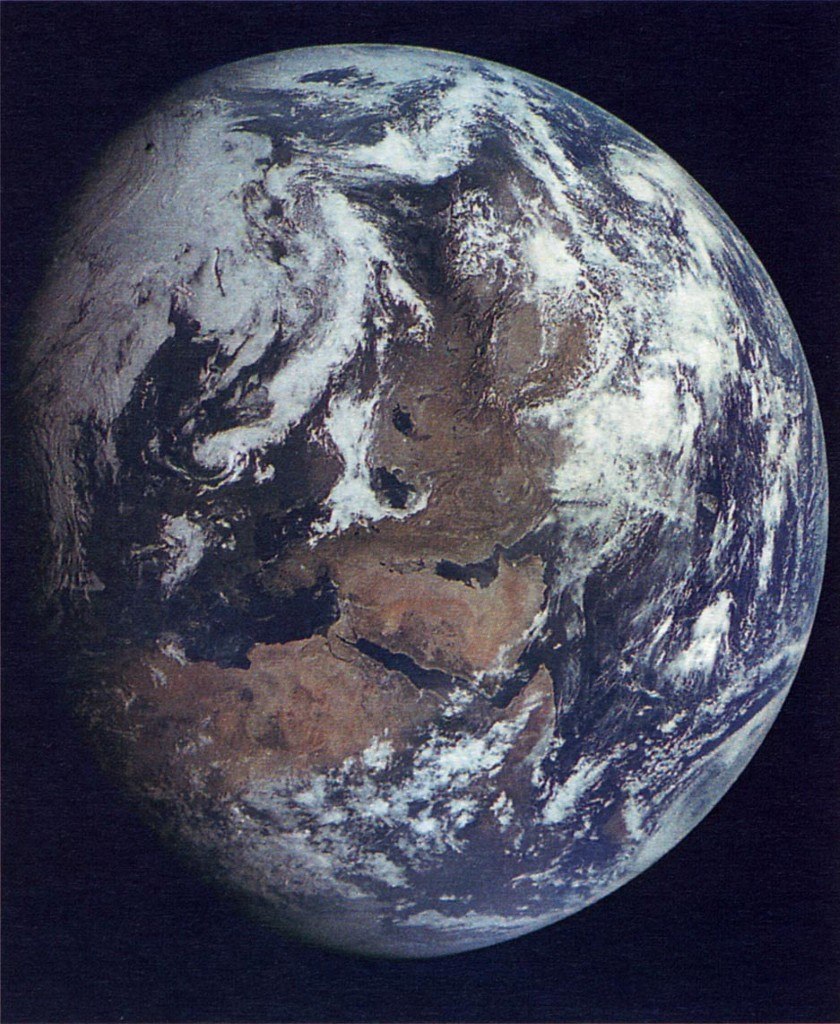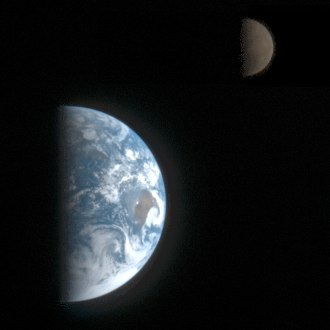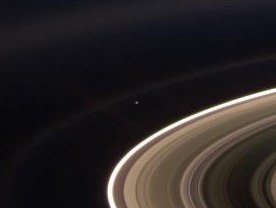Earth through the eyes of an asteroid
On this significant day of the End of the World, I want to talk about what we have, but we forget to appreciate it in the bustle of days. Let's talk about our common Earth. More precisely, let's look at it from space using various automatic and manned vehicles created by our civilization. And let's look at the Earth not from a close, circular or geostationary orbit, but from afar.

This image was obtained by the Rosetta satellite of the European Space Agency. This device hit the road in 2003 and should achieve its goal only in 2014. Such a long journey was calculated so that the apparatus could carefully study the nature of comets. The device flies to comet 67P / Churyumov-Gerasimenko and during its journey returned three times to Earth and flew past Mars once.
Solar eclipse on May 12, 2012 through the eyes of the moon

More precisely, the Lunar Reconnaissance Orbiter lunar orbital probe. To obtain Earth frames, a satellite has to maneuver hard. But such an event as an annular eclipse could not be ignored.
One of the most famous photographs of the twentieth century

was taken manually by the pilot of Apollo-17 on December 7, 1972 during the return of the crew after landing on the moon. The shot was accidental when the position of the ship and the phase of lighting the Earth coincided successfully. It is due to the full coverage of the disk, this photo has long become the only photographic illustration of the entire globe.
A similar photo did not get such popularity even in Russia

Although it was made by the Soviet automatic station Zond-7 on August 11, 1969. In fact, it was an apparatus based on the Soyuz spacecraft and its flight to the moon was part of the “lunar race” program. But the race was lost, therefore, apparently, the results of this work were not particularly disseminated.
The next composition was obtained from the same “Probe-7”. The

second frame in the series is “photoshop”, which was artificially added to make the series uniform.
The Americans got a similar perspective.

This photo was taken from the Apollo-8 on December 24, 1968. ( Someone there complained that NASA was hiding a color photo of the moon. How is color rendering right now? ).
The next series of photos relates to the genre of "last look back."
The first photo is also included in the historical annals.

This is the first ever composition of the Earth and the Moon when viewed from the outside of our planetary system. September 18, 1977 Voyager-1 was removed from the Earth by 11.6 million kilometers and took a picture of his homeland.
A similar shot from a distance of 8 million km.

Made by the European apparatus Mars Express, which tested its optical instruments. In addition to photographing, he was able to analyze the earth's atmosphere and even identified ozone in it.
Going to Jupiter, Galileo turned around and

He managed to capture a dust storm off the east coast of Australia on December 8, 1992.
Proving its undeniable advantage over its European counterpart, the American probe Mars Reconnaissance Orbiter photographed the Earth from a distance of 142 million km

It is this device that allows you to view details up to 25 cm on the surface of Mars. It also confirms its telescopic abilities in astronomical photography, in particular on Earth and the Moon.
One of the most spectacular photographs of the Earth, it doesn’t look like that at all.

A little dot above the left edge of the main ring ... Yes, yes, our baby.

On the full format is better seen.
This 165-frame panorama was obtained during a three-hour serial shooting of the Cassini in orbit on Saturn on September 15, 2006. To Earth - about 1.5 billion km.
And concludes our review, a phenomenal shot that is as boring as it is incredible.

" Pale blue dot"taken by Voyager-1 from a distance of 6 billion kilometers on February 14, 1990. At the suggestion of the famous popularizer of science and space research, Karl Sagan, the device completed the entire" family portrait "of the solar system, which included the blue dot.
A similar feat, perhaps, can be repeated New Horizons, but this will happen in no less than three years, so for now - this is the most distant image of our shared photo with Johnny Depp.

This image was obtained by the Rosetta satellite of the European Space Agency. This device hit the road in 2003 and should achieve its goal only in 2014. Such a long journey was calculated so that the apparatus could carefully study the nature of comets. The device flies to comet 67P / Churyumov-Gerasimenko and during its journey returned three times to Earth and flew past Mars once.
Solar eclipse on May 12, 2012 through the eyes of the moon

More precisely, the Lunar Reconnaissance Orbiter lunar orbital probe. To obtain Earth frames, a satellite has to maneuver hard. But such an event as an annular eclipse could not be ignored.
One of the most famous photographs of the twentieth century

was taken manually by the pilot of Apollo-17 on December 7, 1972 during the return of the crew after landing on the moon. The shot was accidental when the position of the ship and the phase of lighting the Earth coincided successfully. It is due to the full coverage of the disk, this photo has long become the only photographic illustration of the entire globe.
A similar photo did not get such popularity even in Russia

Although it was made by the Soviet automatic station Zond-7 on August 11, 1969. In fact, it was an apparatus based on the Soyuz spacecraft and its flight to the moon was part of the “lunar race” program. But the race was lost, therefore, apparently, the results of this work were not particularly disseminated.
The next composition was obtained from the same “Probe-7”. The

second frame in the series is “photoshop”, which was artificially added to make the series uniform.
The Americans got a similar perspective.

This photo was taken from the Apollo-8 on December 24, 1968. ( Someone there complained that NASA was hiding a color photo of the moon. How is color rendering right now? ).
The next series of photos relates to the genre of "last look back."
The first photo is also included in the historical annals.

This is the first ever composition of the Earth and the Moon when viewed from the outside of our planetary system. September 18, 1977 Voyager-1 was removed from the Earth by 11.6 million kilometers and took a picture of his homeland.
A similar shot from a distance of 8 million km.

Made by the European apparatus Mars Express, which tested its optical instruments. In addition to photographing, he was able to analyze the earth's atmosphere and even identified ozone in it.
Going to Jupiter, Galileo turned around and

He managed to capture a dust storm off the east coast of Australia on December 8, 1992.
Proving its undeniable advantage over its European counterpart, the American probe Mars Reconnaissance Orbiter photographed the Earth from a distance of 142 million km

It is this device that allows you to view details up to 25 cm on the surface of Mars. It also confirms its telescopic abilities in astronomical photography, in particular on Earth and the Moon.
One of the most spectacular photographs of the Earth, it doesn’t look like that at all.

A little dot above the left edge of the main ring ... Yes, yes, our baby.

On the full format is better seen.
This 165-frame panorama was obtained during a three-hour serial shooting of the Cassini in orbit on Saturn on September 15, 2006. To Earth - about 1.5 billion km.
And concludes our review, a phenomenal shot that is as boring as it is incredible.

" Pale blue dot"taken by Voyager-1 from a distance of 6 billion kilometers on February 14, 1990. At the suggestion of the famous popularizer of science and space research, Karl Sagan, the device completed the entire" family portrait "of the solar system, which included the blue dot.
A similar feat, perhaps, can be repeated New Horizons, but this will happen in no less than three years, so for now - this is the most distant image of our shared photo with Johnny Depp.
